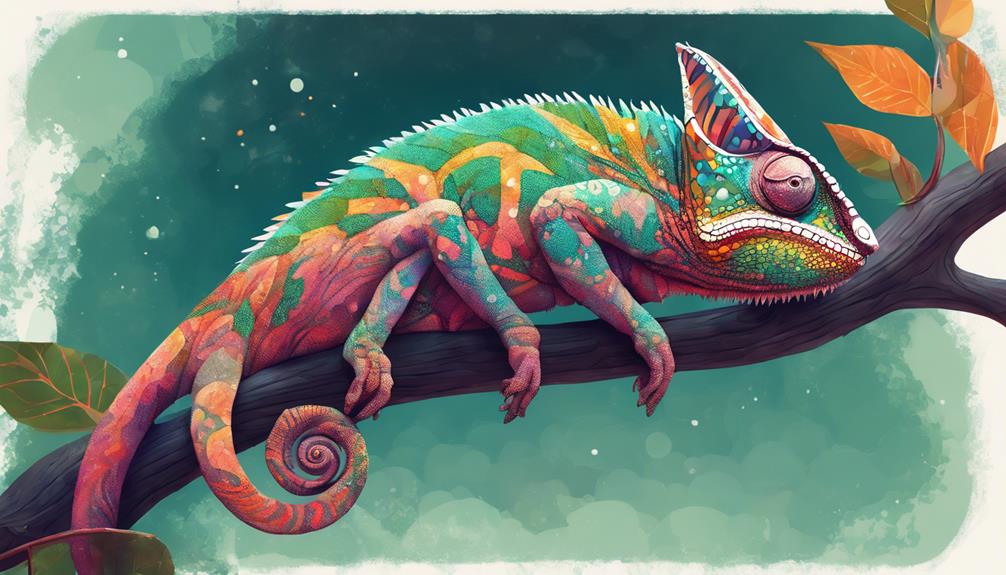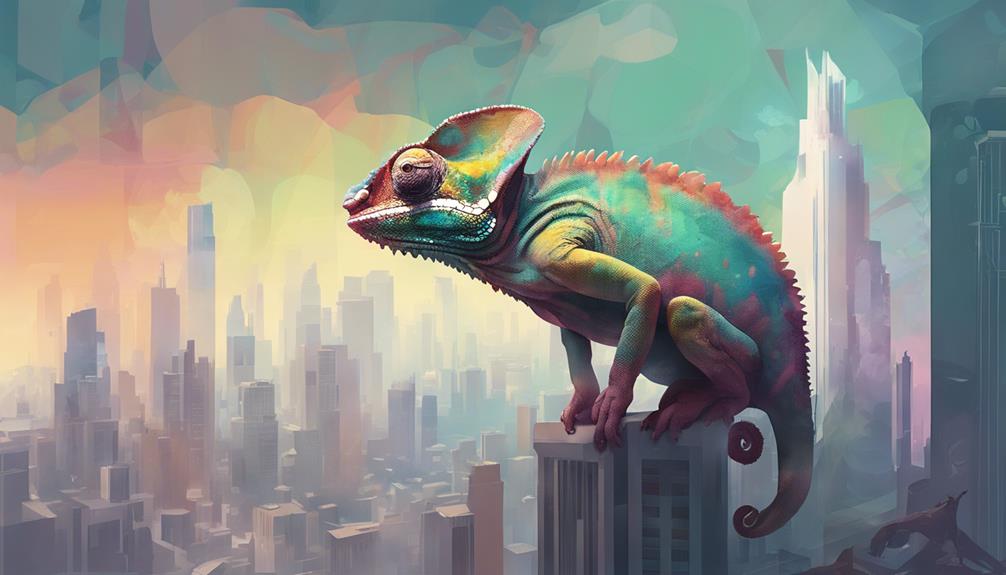Summary
When you think of a chameleon, you probably picture its incredible ability to change color. But a chameleon means much more than that. Symbolically, it represents adaptability and transformation. You will find this in everyday literature and language, where being called a chameleon often means being able to adapt easily to different situations. However, it can also imply someone who changes their behavior to please others, sometimes seen as insincere. Culturally, chameleons carry various meanings, from messengers in African legends to symbols of intuition in ancient Egypt. Want to find out more fascinating details?
Biological wonders of chameleons

Chameleons are fascinating creatures known for their unique ability to change color and blend in with their surroundings. You might think these color changes are just for camouflage, but they are actually also used for communication and temperature regulation. A chameleon's skin has specialized cells called chromatophores, which contain different pigments. By expanding or contracting these cells, chameleons can change their colors.
You will also find their eyes quite remarkable. Unlike most animals, chameleons can move their eyes independently of each other. This means they can look in two different directions at once, giving them a 360-degree view of their environment. It's like having built-in rearview mirrors!
Chameleons have another interesting feature-their long sticky tongues. When hungry, they stick out their tongues at lightning speed to catch insects. Their tongues can be longer than their bodies, making it easier to grab prey from a distance.
Finally, their feet are perfectly designed to cling to branches. With their toes grouped in bundles, they can cling to twigs and climb effortlessly. This helps them navigate their arboreal habitats with ease. Truly, chameleons are a bundle of biological wonders!
Chameleons in literature
You will find that chameleons have long captured the imagination of writers, appearing in various literary works as symbols of adaptability and change. The ability of this fascinating creature to change its color makes it a perfect metaphor for characters who must investigate to survive or thrive in changing environments.
In literature, chameleons often represent transformation. For example, in some stories, a character may be described as ''similar to a chameleon' if it can blend into different social contexts with ease. This can be both a strength and a weakness, showing flexibility but also suggesting a lack of fixed identity.
The authors use chameleons to examine themes related to identity and disguise. Shakespeare, for example, loved to play with these ideas. The characters in his works often disguise themselves or change their behavior to achieve their goals, just as a chameleon changes color.
Children's books also employ chameleons to teach lessons about change and acceptance. A famous example is 'A Color of His Own' by Leo Lionni, in which a chameleon learns that being different is fine.
Symbolism in everyday language

Many people use the term 'cameleon' in everyday language to describe someone who adapts easily to different situations. You might say that a colleague is a chameleon if he or she can blend in with any team, adapting his or her behavior to adapt effortlessly to the dynamics of the group. This type of adaptability can be considered a valuable skill, demonstrating flexibility and the ability to thrive in various environments.
In conversations, calling someone a chameleon often highlights their social skills. Think of that friend who can go from chatting with your grandparents to joking around with your younger siblings without a problem. They are versatile, just like the chameleon that changes its colors.
This term can also describe someone who change their opinions or one's own behavior to adapt to those of others, sometimes to gain acceptance. However, it is not always positive. Being a 'chameleon' might imply that someone lacks a strong personal identity or is too eager to please others. You might hear it used to criticize someone who seems insincere or too changeable.
Cultural significance
In various cultures, the chameleon often symbolizes change, adaptability, and sometimes weakness. You may find it fascinating that in African folklore, the chameleon is seen as a messenger between heaven and earth. This animal's unique ability to change color makes it a symbol of transformation and the fluidity of life.
In ancient Egypt, chameleons were associated with the sun god, Ra. People believed that the chameleon's eyes, which move independently, could see both the past and the future. This made the chameleon a powerful symbol of insight and foresight.
In some Asian cultures, the chameleon's ability to blend in with its surroundings has a dual significance. On the one hand, it is admired for its flexibility and survival skills. On the other, it is sometimes viewed with suspicion for its supposed cunning, as it may appear to be something it is not.
Even in modern Western culture, you will notice that the chameleon is often used in literature and art to represent someone who changes their behavior or appearance to fit in. This can be seen either positively or negatively, depending on the context. The cultural significance of the chameleon is as diverse and varied as the colors it displays.
Human adaptability and change

Just as the chameleon adapts to its environment, human beings possess an incredible ability to change and adapt to new circumstances. Whether we are learning new skills, facing unexpected challenges, or thriving in different cultures, our ability to adapt is remarkable. You may not realize it, but every day you are demonstrating this resilience.
Think about how you have dealt with changes in your life. Perhaps you moved to a new city, started a new job, or even changed your daily routine because of unforeseen events. In each situation, you found ways to manage and succeed.
Here is a simple table to illustrate various areas in which humans show adaptability:
| Status | Challenge | Example of Adaptability |
|---|---|---|
| Moving to a new city | Unknown environment | Learning local customs |
| Starting a new job | New responsibilities | Acquire new skills |
| Health crisis | Physical or emotional stress | Finding new coping strategies |
| Technological changes | New devices and software | Learning to use new tools |
| Social changes | Changed social dynamics | Building new relationships |
Frequently asked questions
What are the different species of chameleons?
There are many species of chameleons out there.
You will find the Panther Chameleon, known for its vibrant colors, and the Veiled Chameleon, who has a helmet-shaped helmet on his head.
Jackson's Chameleon is unique with its three horn-like structures.
Don't forget the Pygmy Chameleon, which is tiny and good at blending in.
Each species has its own interesting characteristics and habitats.
How Do Chameleons Change Color?
Chameleons change color thanks to special cells in their skin called chromatophores. These cells contain several pigments. When a chameleon wants to change color, its brain sends signals to these cells, causing them to expand or contract.
This process changes the way the light reflects on their skin, creating different colors. This helps them blend in, regulate their temperature, and communicate with others. Fascinating, isn't it?
What is the typical lifespan of a chameleon?
You're wondering about the typical lifespan of a chameleon, right? Well, it depends on the species.
Most chameleons live about 5-7 years, but some can live up to 10 years or more in captivity with proper care. Factors such as diet, habitat and stress levels play an important role in their longevity.
Wild chameleons often have shorter life spans due to predators and environmental challenges.
Are chameleons suitable pets for beginners?
Chameleons are not the best pets for beginners. They need special care, such as precise temperatures and humidity, and a specific diet. Their unique needs can be a bit overwhelming if you are new to keeping reptiles.
You will also need to invest in a good enclosure and equipment. However, if you are willing to learn and commit, they can be fascinating pets. Just be prepared for the challenge!
What are the main habitats of chameleons?
Chameleons live mainly in tropical and subtropical regions. You will find them in rainforests, savannas and sometimes even deserts. They love areas with dense vegetation where they can camouflage themselves and hunt insects.
Madagascar is home to many species, but you will also see them in Africa, Asia and parts of Europe. They need a habitat with lots of hiding places and moisture to thrive.
